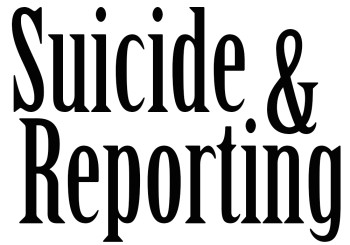
It is an all-too-common story. A body is found, in a bedroom, in a garage or in public. A note, explaining the suicide, is found nearby. Alcohol or drugs, or both, may be found in the victim’s system. Recent depression or ill health or job loss or divorce is suggested as the reason.
As common as suicides are — more than 100 people die by suicide in the United States every day — reporting on them can sorely test journalism ethics. The American Foundation for Suicide Prevention lists suicide as the tenth “leading cause of death in the U.S.” with more than 42,000 Americans dying by suicide annually. The U.S. National Center for Health Statistics said earlier this year that suicide rates in this country are at their highest since 1986. More than 6,000 people died by suicide in the UK in 2014, the Samaritans report. And, after the U.S. presidential election Nov. 8, suicide hotlines faced more than double the calls from people in crisis, the Washington Post reported.
Suicide is unique in that it can often be prevented; on the other hand, there are often cases of copycat suicides, where vulnerable people die because they see others die by suicide or the reaction to it, especially in the news media.
Earlier this year, iMediaEthics discussed best practices for reporting on suicide, highlighting a small Pennsylvania newspaper’s inappropriate coverage of a local death that occurred in public. We’ve frequently written about the sensitive and important matter of carefully reporting on suicide, but with that report, started a series of in-depth looks at suicide coverage in the media.
Most recently, iMediaEthics has examined a story in the News Shopper, a local newspaper in Gravesend, England, on the death of a local woman, Kayley Fothergill, who died at her family home at age 29. iMediaEthics contacted Fothergill’s mother several times for comment on this story but never heard back from her.
While press standards for reporting on suicide advise against including details about the method used, the News Shopper story by James Parsons reported details from the inquest into Fothergill’s October 2015 death. (An inquest is an inquiry into a death.) The story included information about how Fothergill died, the condition of her body when she was found, her abuse of alcohol, Fothergill’s medical issues and mental state and more. It was illustrated with a photo from Fothergill’s Facebook page.
Naomi Taylor, Fothergill’s mother, complained to UK press regulator the Independent Press Standards Organisation that the article included too much information about how her daughter died and that a neighbor’s description of seeing her daughter dead was insensitive. Taylor also said the article was insensitive and shouldn’t have been published, and that it contained inaccurate information.
The newspaper’s December print and online stories were headlined “Gravesend father blames lack of help after depressed daughter found hanged in bedroom” (on Dec. 4) and “Woman found hanged had suffered depression” (on Dec. 9). (The News Shopper is an overarching site for local borough editions like Gravesend, Bromley, Bexley and so on. The News Shopper listed last year on its website that it has a total audience of approximately 443,000.)
After reviewing Taylor’s complaints, IPSO ruled the newspaper did break guidelines for intrusion into grief or shock. The News Shopper stood by its reporting, arguing it was “necessary and justified” to include the information at hand and claiming “no unnecessary and insensitive details were included.”
Further, the newspaper claimed it didn’t report a lot of other information because it was trying to be sympathetic. New Shopper editors did admit that they received a request from a different family member asking the newspaper not to report on the inquest. However, they said, the request came after publication deadline and that the newspaper wouldn’t have agreed anyway because there weren’t any reporting restrictions.
IPSO ruled it was “gratuitous” for the News Shopper to report on a neighbor’s description of the condition of the woman’s body. “Given the potential for such an emotive description to cause distress, its inclusion represented a failure to handle publication sensitively,” IPSO stated.
IPSO, however, concluded that the News Shopper didn’t include an “excessive” amount of information about the woman’s death and that the paper accurately reported on the inquest.
iMediaEthics’ Take
iMediaEthics frequently agrees with IPSO’s rulings, but in this case we diverge at a point. We agree with IPSO that the Gravesend News Shopper shouldn’t have published the description of the body. But, we think the newspaper also included too much information in general, whereas IPSO ruled the article didn’t feature “excessive” information. iMediaEthics’ view is the article went too far, including unnecessary and upsetting information that wasn’t in the public interest to report.
Careful reporting on suicide is important, as iMediaEthics has previously reported, because suicide is considered one of the only preventable causes of death. Experts have found that insensitive, invasive, gratuitous and excessive news coverage of deaths by suicide can lead to copycat deaths by vulnerable people.
IPSO told iMediaEthics, “In short, there is no written IPSO advice on the reporting of suicide. Clause 5 of the Code is pretty clear about the duties of an editor in this area and the Editors’ Codebook (which I know the Code Committee are in the process of updating) has a section on it too – see page 48 – 51. Although it was written pre-IPSO, it is still relevant.”
Ken Norton, the executive director of the National Alliance on Mental Illness, in the United States, noted to iMediaEthics that standards differ between the U.S. and the U.K., but that the article “does cross the usual media line of when media does report on suicide: she was not a public person nor did the death happen in a public place.”
“What exactly is newsworthy about this story?” he asked.
Norton said the description of both the body and how the death occurred went too far and raised concerns about the article assigning blame for the death.
“There is much to object to in this article and not much to like,” Norton wrote to iMediaEthics. “There is nothing that offers readers hope or info about warning signs or where to get help.”
Given that the death was in a private home by a private person, iMediaEthics was frankly surprised there was a story at all. The only real news is that the woman died and that it was by suicide and not a homicide. Any other details are really unnecessary and likely just harm the family and friends of the deceased again. iMediaEthics agrees that the newspaper could have — and should have — featured information about getting help for vulnerable people to balance out the story.
The Society of Professional Journalists’ ethics chair Andrew Seaman likewise noted that there are differences between media in the UK and U.S. and their standards. That said, he commented, “There was no need to really report beyond the death itself.”
Seaman said “there is no value to the community to describe the deceased” and the condition of her body.
“In this case, my recommendation would be to report the death like any other medical condition,” Seaman wrote. “If it warranted a news story, the journalists could simply say she died by suicide. There is no added value to the public by describing how she took her life and how she was found.”
What does the newspaper say?
iMediaEthics contacted the Gravesend News Shopper to learn more about its decisions and judgment in handling the story.
Andrew Parkes, the newspaper’s editor, told iMediaEthics earlier this year that editors approved the story before publication. “My understanding is that several family members and possibly some family friends left negative comments on the website” he said of response to the story. I’m not aware of any negative comments received from anyone else.”
By phone, iMediaEthics asked why the newspaper decided to cover the death of a private person in a private setting. The reasoning, according to Parkes, is that there was an inquest, and the News Shopper reports on inquests because they are newsworthy. “I could argue you either cover inquests or you don’t.” Inquests are “increasingly the most difficult area that we cover,” Parkes told iMediaEthics.
“Reporting an inquest is so sensitive, and you could never tell how they’ll go,” Parkes said. “Sometimes the family desperately wants to talk about it.”
(In the UK, inquests, fact-based investigations and hearings, are often held to learn about deaths. The UK charity website Inquest.org.uk explains an inquest is “a legal procedure presided over by a coroner in the public interest” with several purposes: “to find out the medical cause of death; to draw attention to the existence of circumstances which, if nothing is done, might lead to further deaths; to advance medical knowledge; to preserve the legal interests of the deceased person’s family or other interested parties.”)
While the News Shopper story didn’t make any mention of Fothergill’s family commenting to the newspaper for the story, Parkes said his reporter did contact her family but they declined to talk, saying the family didn’t want the inquest in the press because it “might affect the re-sale value of their house.”
According to Parkes, the newspaper always contacts family of the deceased at inquests. “It is our policy to always approach all families at inquests,” Parkes told iMediaEthics. “The reason for this is two-fold 1. To give family members and/or friends every opportunity to have their say. 2. To make sure the family and friends of the deceased are fully aware the inquest will be reported either in-paper, online or both.”
When asked if the paper follows any practices for reporting on suicides, Parkes told iMediaEthics, “Yes, we comply with the Editors’ Code of Practice.” iMediaEthics asked about suicide reporting guidelines, such as those of the Samaritans, regarding publishing excessive detail, but Parkes stood by the News Shopper‘s article and criticized the Samaritans’ guidelines, saying that the regional press wasn’t involved in the development of the guidelines.
Parkes said the paper didn’t include all of the detailed information about Fothergill’s death even though there was more information available at the inquest. “I do not believe the reporter included any excessive detail of the method used which would encourage anyone to consider a simulative act,” Parkes said.
Parkes added, “I feel it was relevant and necessary to mention the fact Kayley was intoxicated, though again I do not believe this was presented with excessive detail.”
According to Parkes, the paper’s news desk is “trained to review all reporters’ copy from such cases to ensure no unnecessary detail is included which might be considered insensitive.”
Parkes said the description of the body came from the police. While he acknowledged it “could obviously be distressing to members of her family and friends,” Parkes argued it was “relevant” as it “described the neighbour’s anguish at seeing Kayley’s lifeless body.”
Context for Reporting on Suicides & Inquests
The Samaritans, a UK charity that works to prevent suicide and operates a phone line for people who need support, has a great list of advice for journalists reporting on suicide. The list includes important reminders such as “think about the impact of the coverage on your audience,” and “exercise caution when referring to the methods and context of a suicide.”
The Samaritans say news outlets shouldn’t include “too much detail” especially about how the person died and point out that it’s “misleading” to suggest why someone died by suicide.
IPSO’s guidelines related to reporting on suicide dictate:
“When reporting suicide, to prevent simulative acts care should be taken to avoid excessive detail of the method used, while taking into account the media’s right to report legal proceedings.”
Inquest.org.uk’s website states: “Because an inquest is a hearing in public, the press may attend and report on what has happened. Some families want there to be press attention, but some do not. You cannot stop the press from writing about the hearing, but they do have a code of ethics and should be sensitive to grieving families.”
The website points to the ethics guidelines for journalists in the UK published on the Press Complaints Commission, which is the former press regulator for many UK print media outlets. The PCC closed several years ago and has been replaced by the Independent Press Standards Organisation.
In a separate April 7 report, the News Shopper brought up Fothergill’s death again, reporting on the inquest again for no apparent reason, even noting that Fothergill’s stepfather wanted the inquest to be private. Fothergill’s mother took to the comments of that article to complain and express her grief.
In April, iMediaEthics highlighted a particularly egregious example of how not to report on suicide, focusing on the Sharon (Penn.) Herald’s gratuitous and invasive coverage of a local man’s death by suicide. The story horrified the man’s mother, who said she was “disgusted with a newspaper that has no respect for human life…most especially my son’s life.”






Comments Terms and Conditions